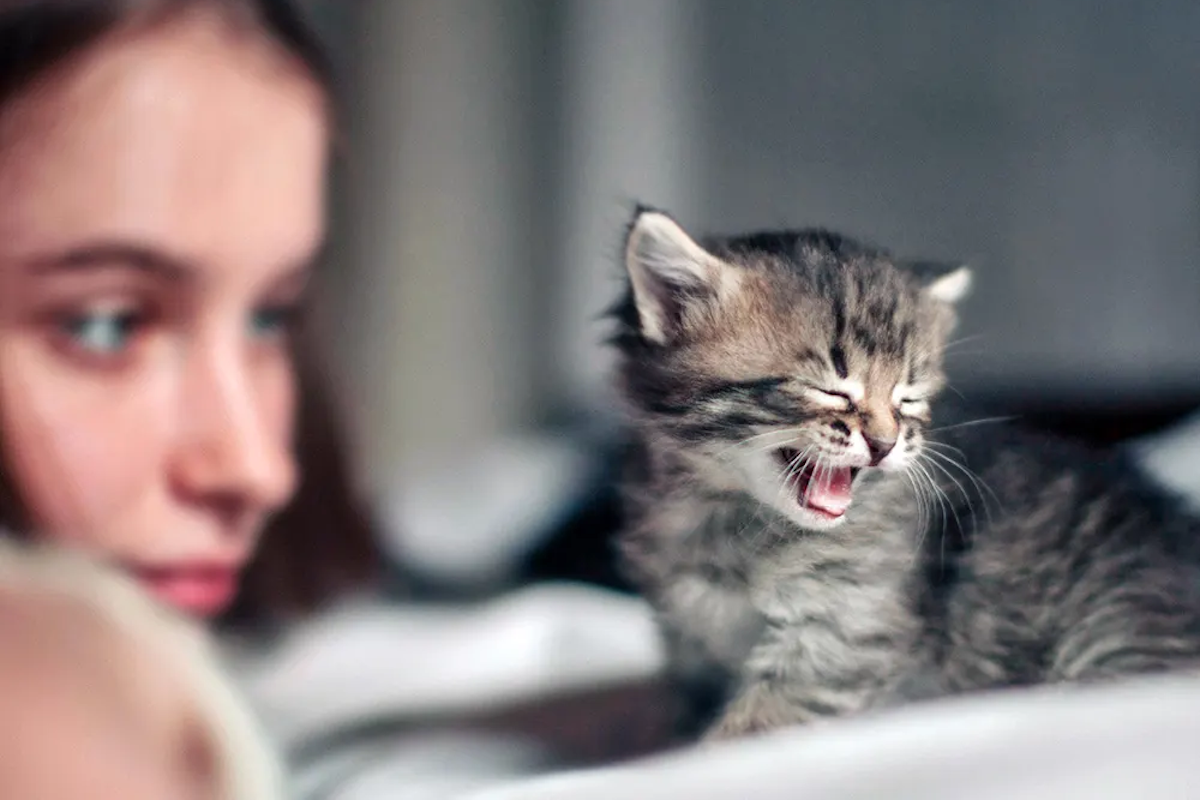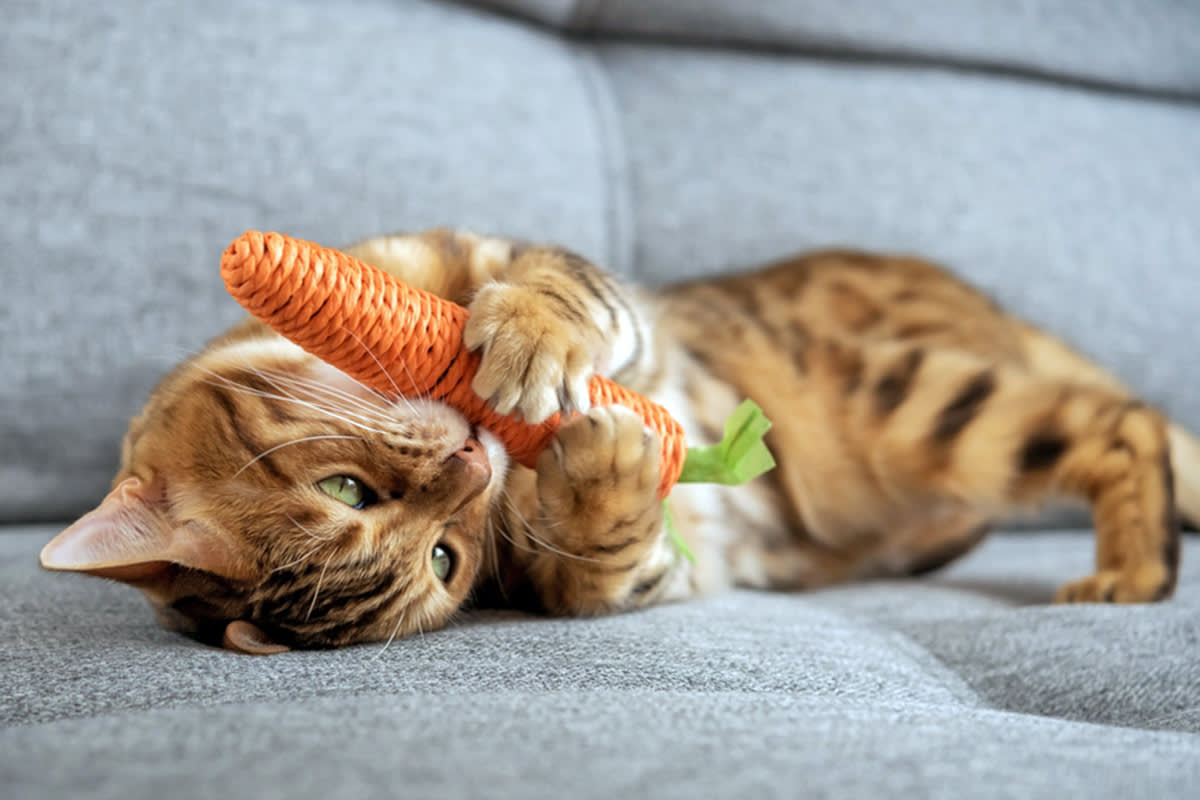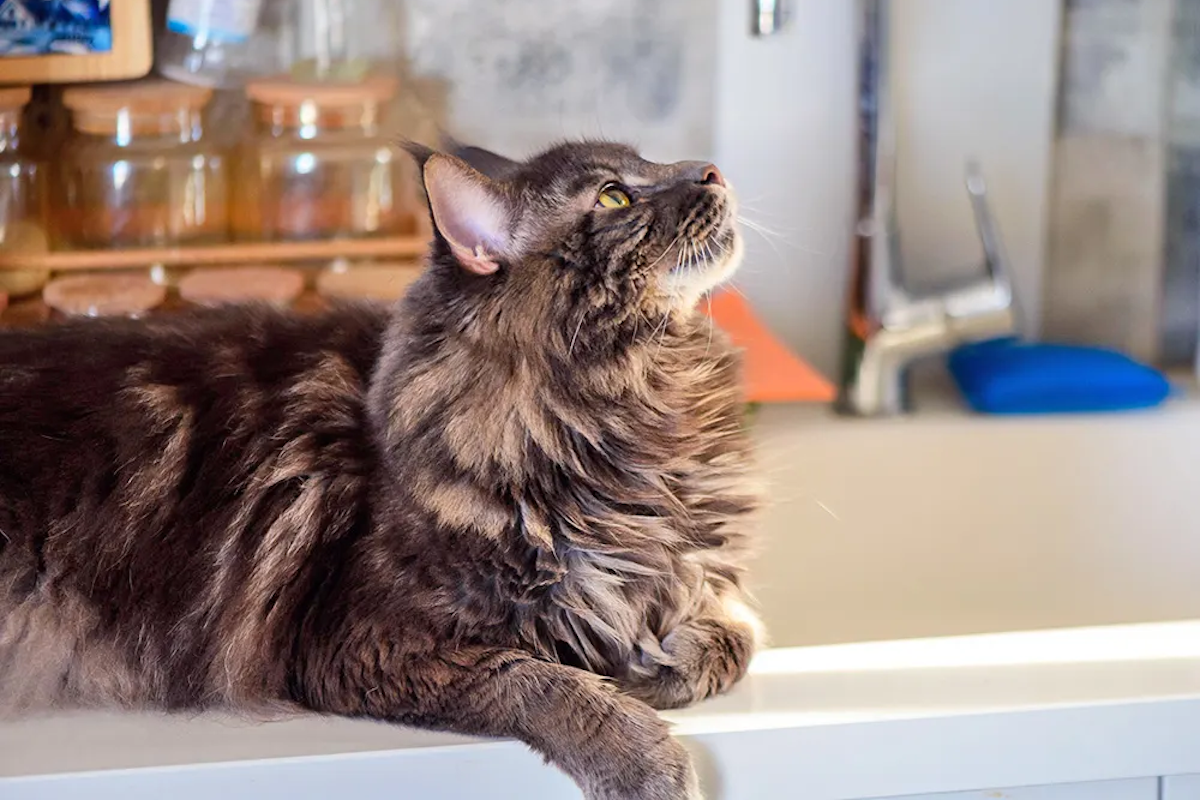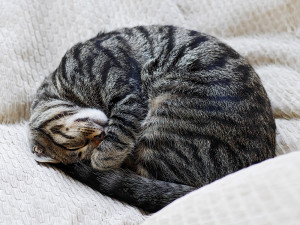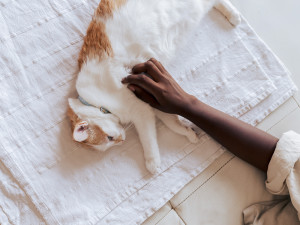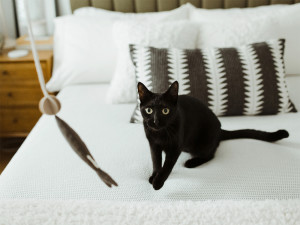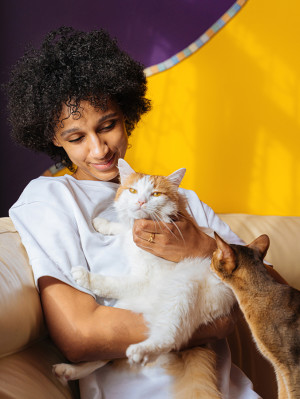11 Signs Your Cat Is Not Getting Enough Playtime
Tattered couch cushions are only one consequence of a bored kitty.
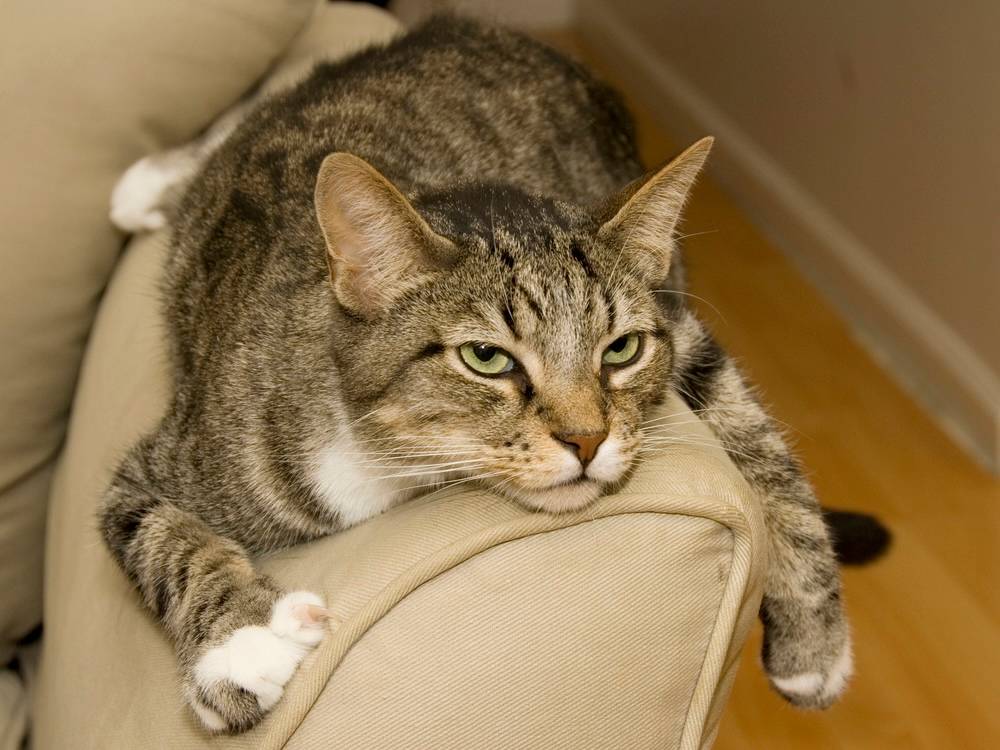
Share Article
It’s a widespread misbelief that cats are low-maintenance creatures who thrive on little-to-no human interaction. Along with this idea comes the notion that they are perfectly happy to spend all day and night just lying around, eating, and receiving the occasional head scratch. They purr when we stroke them, and we think they are content. But there is something missing, and that something is play. Lots of it. Probably more than you are currently giving them.
“So much of the work I do is because people are not playing with their cats enough,” says Jennifer Van de Kieft, feline behavior specialist at Cat Advocateopens in new tab. “There are other reasons, too, obviously, but most of the calls I get are about unwanted behaviors, which almost always are the result of cats not getting enough playtime.”
Cats are hunters by nature, and play allows them to satisfy their primal, instinctual need to stalk prey, pounce, kill, and generally get physical, while still remaining safely indoors. Play allows them to exercise their bodies and, more importantly, their minds.
Sometimes, play can seem boring to humans, especially if the cat they are playing with is not super active and spends more time watching their toy than physically engaging with it, but watching is part of the fun for cats. And just because their bodies aren’t in motion doesn’t mean their brains aren’t whirring. They are!

Here’s the thing: In the wild, a cat only has one shot to catch their prey. They have to make it count. So, they watch, they wait, and they only strike when they feel confident that they can make a kill. After all, if a wild cat tries and fails too many times to catch a meal, they will run out of energy, and then they will be at risk of either starving or being too weak to defend themselves from a predator.
Of course, your cat doesn’t have to worry about where their next meal is coming from or whether a larger animal is going to come by and gobble them up. But play isn’t just about satisfying urges related to survival. It’s also about disrupting the monotony of a life spent indoors. Without regular interventions, cats can easily get bored. That boredom can then turn into stressopens in new tab. And that stress can and often will result in unwanted behaviors.
How do you know your cat needs more play?
They keep biting stuff.
Chewing on random bits of cardboard, paper, plastic, etc isn’t just about satisfying an oral fixation. Often, it is a response to boredom. They’ve got pent-up energy and nothing to do and nowhere to go, so they gnaw whatever is at hand.
They stalk and pounce on you.
Ever had your cat lie in wait for you to pass and then jump out and nip at your ankle? Feline behavior and training expert Stephen Quandt of Cat Behavior Helpopens in new tab calls this a “drive-by ankle biting.” Cats need to hunt, and in the absence of anything else, you become their prey. “You become like a giant mouse to them,” Quandt says. “And in that moment, you act like a mouse: making noise, jumping back, and scurrying away.”
“This kind of play aggression might not feel terribly playful when you’re on the receiving end of it,” says Van de Kieft, “but they are only engaging with you in this way because they have predator energy that needs to be released and you’ve likely given them no other outlet.”
They get the zoomies!
Those moments when your cat goes crazy and starts running around the house like a bat out of hell? Take those as a clear sign that they need more play and they need it now. They’ve got so much energy that they could probably parkour off the living room walls. Whip out a wand toy and give them five to 15 minutes of exercise until they get their zoomies out.
They vocalize excessively.
Some cats are just talkers, but if you notice that yours is talking more than usual, assume that what they are saying is: “I need more playtime.”
“Often, when cats come up to you and start yowling, it is because they have learned that when they do that, you are more likely to take action,” says Joey Lusvardi, certified cat behavior consultant at Class Act Catsopens in new tab. If you want to discourage this behavior, you may not want to play with them at that exact moment, but you should make a point of playing with them soon and often.
They engage in destructive behavior.
Cats don’t destroy your whole house because they are mad at you. They likely don’t even view what they are doing as destructive. At least, not the same way you do. If your cat pees on the bed, for example, they are not doing it to teach you a lesson or get revenge.
They are crying out for help. This is not to say that peeing on the bed means they want more play exactly, but if they are engaging in destructive behaviors of any kind, it’s worth examining if you are really giving them enough playtime. After all, all three of our experts confirm that a lack of adequate play is at the root of almost all the destructive and negative behaviors they see in their work.
They bring you toys or play on their own.
If you notice your cat playing with a toy on their own, and you have the time to engage with them in a more meaningful way yourself, do it. Most cats would almost always prefer a good wand-toy session over batting around a felt mouse.
Quandt also suggests paying attention to how your cat is playing on their own in order to figure out exactly what will best satisfy them at that moment. “If they are focused on an object like a mouse or a wand toy, play with a toy,” says Quandt, but be open to other ways they might be trying to engage you as well. “Sometimes, my cat, Jenny, will hide in the tub and meow until I come find her. Then, when I do, she runs and hides somewhere else and I go find her again, like hide and seek. You need to play how they want you to.”
They are knocking things off tables.
Ever notice how cats will sometimes wait until you are looking at them to casually just toss something off the table? They want you to react. They want you to engage with them. If you play with them more often, they will likely not feel the need to randomly make your belongings clatter to the floor.
They climb on counters or go places they are “not supposed to go.”
“Cats don’t care about should or shouldn’t,” Lusvardi says. “If they are bored, they will go investigate places they think might have something they can play with.”
It’s possible that you are encouraging this behavior without even realizing it. If you give your cat attention (even negative attention) every time they go where they shouldn’t — be it on a counter or on a cluttered shelf — they will learn to do this more often, not less. Especially if you are not giving them adequate attention otherwise.
They are engaging in repetitive behavior.
“Unusual, repetitive behaviors can be an indication that a cat is trying to find ways to fill their time,” Lusvardi says. “My cat, Poutine, for instance, used to play with one of my door jambs all the time, but we play constantly now, so the door jamb has lost some of its appeal.”
Of course, playing with a door jamb isn’t the worst thing a cat can do, but if you notice that your cat is engaging in a new, repetitive behavior — like over-grooming or pacing or playing with something they shouldn’t (like your couch cushions)— try engaging them in regular play and see if the behavior ceases. It probably will. And if it doesn’t, of course, take them to the vet and have them checked out.
They wake you up on the middle of the night.
“You really don’t have to accept being woken up at 3 a.m. by a yowling cat,” Van de Kieft says. Often a few regularly scheduled play periods throughout the day and a good one at night, before bed, are all it takes to get your cat to chill out during the wee hours.
It’s not really about wearing them out so much as it is about giving them enough stimulation that they don’t become desperate and try to get it from you when you’re trying to sleep.
They are getting all up in your face.
I recently took in a foster cat, and when she jumps up on the desk while I’m writing or gets right up in my face while I’m on the couch, I know she’s hankering for some playtime. I know this because I play with her, then I give her a treat, and then she chills out. Sometimes, she just wants some affection, but most of the time, she wants to play.
How much should you play with your cat?
The short answer is: as much as possible. But “typically, it’s a good idea to shoot for two to four short play sessions throughout the day,” Lusvardi. says “Five to 15 minutes — depending on the age, energy, and needs of the cat.”
My new foster cat, for example, is 17 years old, so play sessions only last about three minutes, but she probably gets six of them throughout the day.
Don’t try to force an extra long play session on your cat if they don’t want it. That might seem like the key to wearing them out, but it can be hard to actually keep a kitty’s attention for that long. Lusvardi says that multiple shorter sessions are actually much more effective, even with younger, more energetic cats. If they get used to regular play sessions, they won’t be so anxious about when their next one is coming, and they may become more calm overall.
If you need to engage in regular, scheduled playtime, try doing so before meals; this will help satisfy your cat’s natural hunt-eat-sleep cycle. This is also why it is always a good idea to follow up a hearty play session between meals with a treat.
As tempting as it may be to invest in high-tech toys that your cat can play with on their own, the fact is that no automatic toy can mimic the behaviors and movements of prey better than you can with just a simple wand toy and a little patience. Cats need to play, and they need to play with you. Play is as much about mental stimulation as physical exercise, and they need you there to make it happen for them.

Charles Manning
Charles Manning is an actor and writer based in New York City. In his free time he likes to cook, go swimming at the public pool, volunteer at the LGBTQ senior center, and foster senior and special-needs cats. His work has previously appeared in Cosmopolitan, Elle, Marie Claire, Harper’s Bazaar, Seventeen, and Nylon.
Related articles
![Curled up tabby cat sleeping on pillows]()
Why Do Cats Sleep So Much?
A very sleepy kitty isn’t usually a problem, but watch out for these signs of medical distress.
![Unrecognizable woman petting an ill cat]()
5 Common Types of Cancer in Cats, Symptoms, and Treatments
Learn how to spot the early signs to how to treat them.
![Black cat staring at a cat toy]()
How to Play With Your Cat
Cat behaviorist Cristin Tamburo’s got a game plan.
![Woman playing with her cat.]()
Your Cat Really Wants You to Play With Them—Here’s How
It’s the key to a happy cat.
![A woman with curly black hair sitting in front of a dark purple and yellow backdrop while looking down affectionately at her two cats sitting on her lap]()
How to Build Your New Cat’s Trust in You
If your cat still approaches you with a figurative arched eyebrow of skepticism, try these tricks to put them at ease.


